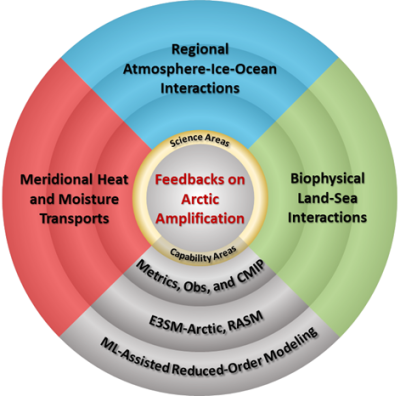High-Latitude Application and Testing of Earth System Models (HiLAT-RASM)
Project Team
Principal Investigator
Collaborative Institutional Lead
Project Participant
The High-Latitude Application and Testing of Earth System Models (HiLAT) Science Focus Area (SFA) is teaming up again with the Regional Arctic System Model (RASM) project to study feedbacks that contribute to Arctic Amplification. This accelerated warming of the Arctic is having major and unprecedented impacts on every aspect of the Arctic Earth system. Our ability to anticipate these changes is hampered by incomplete knowledge of the complex Earth system feedbacks that modulate Arctic warming and by the challenges of translating this knowledge into model fidelity.
The HiLAT-RASM Phase III aims to improve our ability to project future Arctic changes by developing a unifying framework to understand, quantify, and compare complex Earth system feedbacks that modulate Arctic warming, and to improve the model representation of such feedbacks. The unifying framework is designed to examine feedbacks across two dimensions. We will investigate feedbacks from a wide range of processes represented by three Science Areas, namely meridional exchanges of heat and moisture between high and low latitudes; complex regional feedbacks between the ocean, sea ice, and atmosphere; and complex feedbacks between the terrestrial, aquatic, and biogeochemical domains. In addition, we will study individual feedbacks across models with a range of complexities represented by three Capability Areas, namely from broad-ranging multi-model examination in the CMIP6 ensemble; through detailed investigation in our higher-resolution models E3SM-Arctic (DOE E3SM model with refined meshes in the Arctic) and RASM; to intuitive and efficient Machine Learning-assisted Energy Balance Models.


